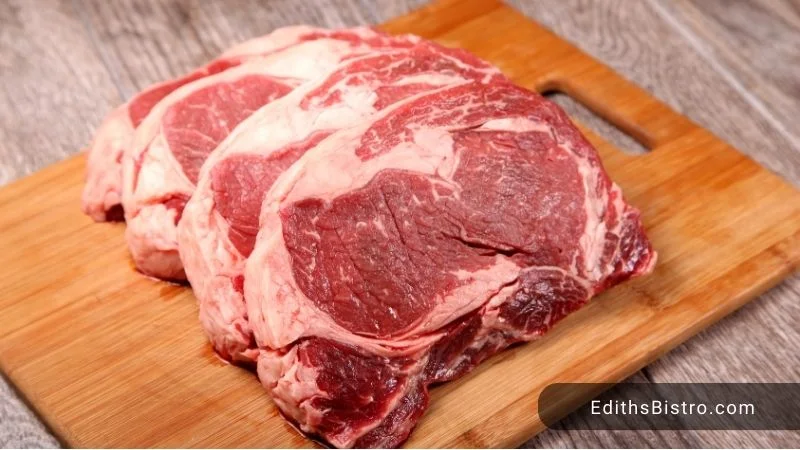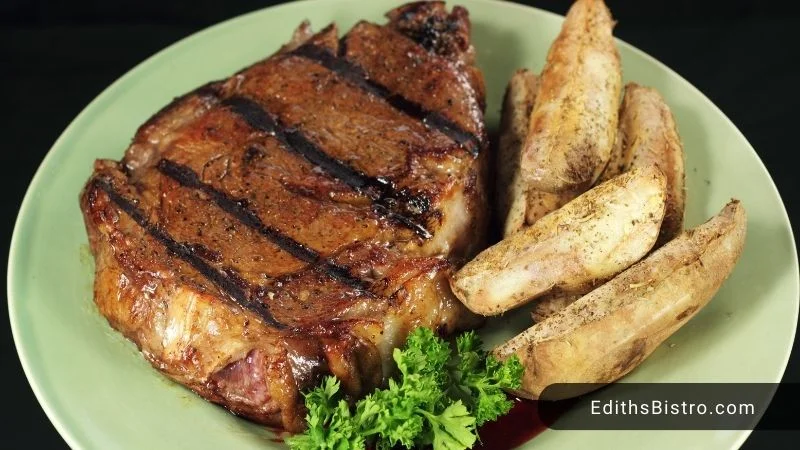“What is the difference between ribeye and Delmonico steaks?” is a common question among steak enthusiasts. While both are celebrated for their deliciousness, their distinctive characteristics set them apart. Let’s explore their origins, texture, flavor, and more to understand the key differences between ribeye and Delmonico steaks right now!
What Is The Difference Between Ribeye And Delmonico Steaks?
The main differences between ribeye and Delmonico are their meat cut, cost, taste, and tenderness.
Ribeye steaks, derived from the cow’s rib section, are known for their exceptional tenderness and rich marbling, making them more expensive. In contrast, Delmonico steaks can be made from various cuts, most commonly ribeye, chuck eye, and sirloin, and are more affordable but less marbling.
What’s more, Delmonico steaks are typically thicker than ribeye steaks.
What is a ribeye steak?

Ribeye steak is a sought-after cut of meat celebrated for its exceptional tenderness and rich flavor. Ribeye steak is cut from the rib primal section of the cow, typically situated near the upper back and just behind the shoulder.
The signature feature of a ribeye is the central “eye” of lean meat, surrounded by a well-marbled periphery, creating a delectable balance of tenderness and flavor.
Ribeye steaks come in boneless or bone-in variations, where bone-in ribeyes include a section of rib bone. This bone can either extend a few inches beyond the meat or be trimmed to align more closely with the steak’s edges.
The primary muscle in a ribeye steak is the longissimus dorsi, an extended and tender muscle extending from the cow’s hip bone to the shoulder blade.
Pros
- Exceptional tenderness
- Rich marbling for added flavor
- Easy-to-find steak
Cons
- Expensive steak
- Higher fat content
- Careful cooking requirements
What is a Delmonico steak?

Delmonico cut, initially popularized by Delmonico’s restaurant in New York city in the mid-19th century, is typically made from ribeye beef and is characterized by its thick-cut preparation.
A genuine Delmonico steak is sourced from the first 3 inches of the chuck eye. Still, regional variations in the United States can lead to the term “Delmonico steak” used for various thick-cut steaks made from different steak cuts.
Delmonico steak often refers to any thick-cut steak preparation, with the ribeye being a common choice.
Pros
- More affordable price
- Robust, beefy flavor
- Leaner profile
- Compatible with several cooking methods
- Thick cut
- Both bone-in and boneless variations
Cons
- Less tender than ribeye
- Less marbling than ribeye
Key differences between ribeye and Delmonico steaks
| Characteristics | Ribeye steak | Delmonico steak |
|---|---|---|
| Naming | Ribeye steaks, sometimes called ribeye, derive their name from the cut’s source – the cow’s rib section. | Delmonico steak comes from the renowned Delmonico Restaurant, a famous steakhouse in New York City. |
| Meat cut | These steaks are derived from the rib section of the cow. | Delmonico steaks can come from various cuts, but they are often made from the ribeye or chuck eye, specifically the first 3 inches of the chuck eye. |
| Cost | Typically, ribeye steaks are pricier due to their high-quality meat and generous marbling ($10 – $15 per pound). | Delmonico steaks can offer a more budget-friendly option as they may include different cuts, making them cost-effective ($4-$10 per pound). |
| Size | A standard ribeye steak weighs around half a pound and is commonly 1.5 inches thick. | A Delmonico steak can range from 0.875 to 1 pound and tends to be thicker at around 2 inches. |
| Appearance | These steaks are recognized by their round or oval shape and ample marbling, manifesting as fat streaks throughout the meat. | Because Delmonico steaks are sourced from various regions of the animal, their fat content can vary, but they usually contain less fat and exhibit milder marbling compared to ribeye steaks. |
| Texture | Ribeyes are renowned for their consistent tenderness across the entire steak. | Delmonico steak tends to have a heartier and leaner quality. |
| Bone content | Ribeye steaks may come bone-in (with the rib bone) or boneless, providing different textures and flavors. | Delmonico steaks are typically boneless. |
| Fat content | Ribeye steaks are renowned for their marbling, contributing to their higher fat content. | Delmonico steaks may have less marbling and fat content, depending on the cut. |
Which Is Better: Delmonico Vs Ribeye Steak?
Choosing between ribeye and Delmonico steak involves personal preferences and budget considerations. Thus, you need to understand the difference between Delmonico and ribeye steak. Ribeye is celebrated for its exceptional tenderness, marbling, and rich flavor, often making it a favorite among steak lovers. This cut of steak is frequently deemed the superior choice in terms of taste and texture.
Conversely, Delmonico steak offers a more cost-effective alternative, delivering a robust, beefy flavor. While it may not match ribeye’s tenderness, Delmonico steak is also a flavorful option when prepared thoughtfully. Delmonico steak can be a satisfying selection if you’re seeking an economical steak choice or enjoy a heartier beef taste.
Ultimately, the decision hinges on individual taste and financial factors. If tenderness and marbling are paramount, ribeye is likely the superior pick. However, if budget constraints come into play or you prefer a robust beefy profile, Delmonico steak can provide a delicious and budget-friendly alternative.
FAQs
What is special about a Delmonico steak?
In its simplest form, a Delmonico steak is a substantial cut, often reaching up to two inches in thickness. The key to a great Delmonico steak is its exceptional quality, boasting abundant marbling for maximum flavor. This cut must be sourced from the beef’s rib or short loin portion for the best results.
Are Delmonico and ribeye steaks the same?
No, they are not the same. Delmonico steak is often used as a broader term for a high-quality, thick-cut steak, and it doesn’t always refer to a specific cut from the beef. Ribeye, on the other hand, is a specific cut that comes from the cow’s rib section and is known for its rich marbling and exceptional flavor.
Therefore, while a ribeye steak can be considered a Delmonico steak, not all Delmonico steaks are necessarily ribeyes.
What makes a ribeye steak Delmonico?
A ribeye steak can be referred to as a Delmonico steak when prepared in the style associated with Delmonico’s restaurant. In particular, a ribeye steak that is thick and boneless can be considered a Delmonico steak.
References:
- Wikipedia – Delmonico steak – https://en.wikipedia.org/wiki/Delmonico_steak
- Wikipedia – Rib eye steak – https://en.wikipedia.org/wiki/Rib_eye_steak






![What To Pair With Quiche? 25+ Best Dishes [With Pictures]](https://www.edithsbistro.com/wp-content/uploads/2024/04/what-to-pair-with-quiche-160x90.jpg.webp)
